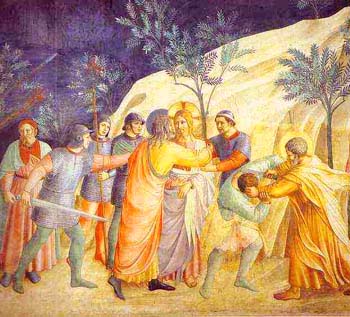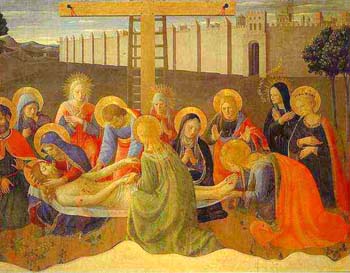 |
The Saint of the Day
St. Mary Magdalene, July 22
Prof. Plinio Corrêa de Oliveira
Biographical selection:
Commenting on St. Mary Magdalene, the Roman Martyrology says that after Our Lord expelled the devils from her, she became so perfect that she was worthy to be the first person to see Him resurrected.
Comments of Prof. Plinio:

Mary Magdalene was the first one to see Our Lord after His Ressurection - Laurent de La Hyre, 1656
|
The famous episode in a banquet where St. Mary Magdalene washed the feet of Our Lord Jesus Christ with perfume reveals some facets of her personality and her position in the Church.
We know that she was a sister of Lazarus. According to the traditions and documents of that time, he was a person of high society, because he had a rank of a prince and was very wealthy. He had been a prince of a small people who had been incorporated into the Jewish nation, and still had the title and honors of a prince even though he no longer played a political role. Therefore, he and his two sisters, Mary and Martha, were persons of a high social level.
However, Mary Magdalene strayed from the good path and became a public sinner. She repented profoundly and became a model of two different things: contemplation and penance.
Her contemplation was marked in contrast with the active life of Martha, who censured Mary for not caring about the needs of the house but only about staying close to Our Lord listening to Him and admiring Him. Our Lord told her: "Martha, Martha, Mary has chosen the better part, and it will not be taken from her." She represents pure contemplation, unlinked to the active life.
Her repentance, her penance, and her perfect fidelity prepared her to stand with Our Lady and St. John at the foot of the Cross. Her penance was so perfect and the pardon she received so great that she achieved an extraordinary union with Our Lord. Studying her case, some serious theologians even raised the hypothesis that perhaps penance is more beautiful than innocence.
In the episode of the banquet, she represented penance, contemplation and complete detachment from worldly goods. To the contrary, Judas represented treason, hatred dissimulated under the pretext of charity, and attachment to material things. The opposition between Mary Magdalene and Judas could not be more flagrant.
After that episode, the opposition continued. She, the repentant sinner, was faithful and stood at the foot of the Cross. He, the damned Apostle, was the one who delivered Jesus Christ to be crucified. She was the first to witness the Resurrection of Our Lord and His ascension to Heaven to meet the Eternal Father; the impenitent Judas hanged himself in despair and hurled himself into Hell to meet the Devil. The antitheses are strong and expressive. On one hand, in Mary Magdalene, we see repentance, pure contemplation and detachment from worldly goods. On the other hand, in Judas, we find final impenitence, total attachment to money and cupidity for worldly goods.
St. Louis Grignion of Montfort distinguished two types of human psychology: those who are like Jacob and those like Esau. St. Mary Magdalene is characteristic of one with the spirit of Jacob: she had a superior soul turned toward heavenly things and indifferent to the things of this world. Judas, the opposite, was a type like Esau. He not only sold his birthrights for a plate of lentils, but much worse, he sold his Savior for thirty coins.

Above, Fra Angelico painted Judas with a black halo. Below, Mary Magdalene, kissing the feet of Our Lord,
has a gold halo
 |
Fra Angelico painted the scene of the kiss of Judas delivering Our Lord to the Jewish soldiers. He painted Our Lord’s head surrounded with a golden halo, and Judas’ head with a black halo. He wanted to express that Judas was the son of iniquity, the damned Apostle whose spirit was one of sin and darkness, while Our Lord’s was filled with sanctity and light. We could apply this to the contrast between St. Mary Magdalene and Judas. One had a golden halo, the other a black halo.
When St. Mary Magdalene repented, she completely rejected all those things that had induced her to sin. In her case, this constituted the brilliant things of life. As penance she distanced herself totally from such things, she completely detached herself from them. To achieve such detachment she abandoned all links with the active life and became a pure contemplative. Her contemplation, therefore, was born from penance and detachment. It made her understand the excellence of heavenly things and how every created thing was made to serve and glorify heavenly things. So, nothing could be more consistent for her than to take a very valuable perfume and pour it on the divine feet of Our Lord Jesus Christ.
What had induced the despicable Judas to be attached to money, which led him to hate Our Lord? Yes, I say hate, because no one betrays the Man-God as he did only for a profit. What induced Judas to steal the alms collected for the poor? No one can know for sure, but one can raise a hypothesis.
When Our Lord was preaching His doctrine, Judas was probably thinking about other things, for instance, about the prestige of the Pharisees in Jerusalem and how he would like to do something to impress them. So, he wanted to become rich and have a parallel career in order to be considered an important man by the Pharisees. He started to think about these things of this world and fell into sin, he started to steal money. This habit made him more and more hostile to Our Lord. The process continued to the final extreme, where Judas handed over Our Lord to the ones he admired and wanted to impress, and also to make some money.
The processes of both, Mary Magdalene and Judas, are logical. One has the logic of the golden halo; the other, the logic of the black halo. The pathway of a woman who was in sin and became a saint crossed the pathway of an Apostle who was in grace and became a traitor.
What was the most profound reason why one repented and other fell into despair? In my opinion it is because of their different relations with Our Lady.
St. Mary Magdalene was always close to Our Lady, helping her and giving her support, above all at the supreme moment when her Son was crucified and died on Calvary. Judas, however, was cold toward Our Lady. Catharine Emmerick says that before the treason was consummated, Our Lady, who knew what he was planning, approached Judas and spoke with him for a long time, trying to convert him. He rejected everything, and the Gospel affirms that after the Last Supper, the Devil entered his soul.
The woman who had warm and close relations with Our Lady became one of the greatest saints of the Church, who in Heaven certainly is very close to the Sacred Hearts of Jesus and Mary. The Apostle who was cold toward her became the son of perdition, who was pictured by Dante inside the very mouth of Satan in the deepest place of Hell.
This contrast has many lessons. The principal one is for us to be as close as possible to Our Lady, no matter what our situations are, whether we be in the state of grace or in sin.


  | | Prof. Plinio Corrêa de Oliveira | |
The Saint of the Day features highlights from the lives of saints based on comments made by the late Prof. Plinio Corrêa de Oliveira. Following the example of St. John Bosco who used to make similar talks for the boys of his College, each evening it was Prof. Plinio's custom to make a short commentary on the lives of the next day's saint in a meeting for youth in order to encourage them in the practice of virtue and love for the Catholic Church. TIA thought that its readers could profit from these valuable commentaries.
The texts of both the biographical data and the comments come from personal notes taken by Atila S. Guimarães from 1964 to 1995. Given the fact that the source is a personal notebook, it is possible that at times the biographic notes transcribed here will not rigorously follow the original text read by Prof. Plinio. The commentaries have also been adapted and translated for TIA's site.
|
Saint of the Day | Home | Books | CDs | Search | Contact Us | Donate

© 2002- Tradition in Action, Inc. All Rights Reserved
|
 |

|